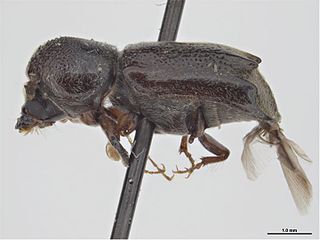
Eupsilobiidae is a family of beetles in the superfamily Coccinelloidea, formerly included within the family Endomychidae. Most genera are restricted to the Neotropics, while the genus Eidoreus is found worldwide. They are fungivores, and have been observed living commensally in bee and ant nests.
Niptinus is a genus of spider beetles in the family Ptinidae. There are at least two described species in Niptinus.
Bystus ulkei is a species of beetle in the family Anamorphidae. It is found in North America.
Bystus is a genus of beetles in the family Anamorphidae. There are about six described species in Bystus.

Aphorista is a genus of handsome fungus beetles in the family Endomychidae. There are at least four described species in Aphorista.

Mycetina is a genus of handsome fungus beetles in the family Endomychidae. There are about 11 described species in Mycetina.
Epipocinae is a subfamily of handsome fungus beetles in the family Endomychidae. There are at least 4 genera and more than 40 described species in Epipocinae.

Lycoperdina is a genus of handsome fungus beetles in the family Endomychidae. There are about 16 described species in Lycoperdina.

Stenotarsus is a genus of handsome fungus beetles in the family Endomychidae. There are more than 50 described species in Stenotarsus.

Phymaphora californica is a species of handsome fungus beetle in the family Endomychidae. It is found in North America.
Leiestinae is a subfamily of handsome fungus beetles in the family Endomychidae. There are at least three genera and about five described species in Leiestinae.

Dendrobiella is a genus of horned powder-post beetles in the family Bostrichidae. There are about seven described species in Dendrobiella.
Dearthrus is a genus of carpet beetles in the family Dermestidae. There are at least two described species in Dearthrus.

Rhanidea is a genus of handsome fungus beetles in the family Endomychidae. There is one described species in Rhanidea, R. unicolor.

Apatides is a genus of horned powder-post beetles in the family Bostrichidae. There are at least four described species in Apatides.

Mesocoelopus is a genus of death-watch and spider beetles in the family Ptinidae. There are about six described species in Mesocoelopus.

Holoparamecus is a genus of handsome fungus beetles in the family Endomychidae. There are about 17 described species in Holoparamecus.

Phymaphora pulchella is a species of handsome fungus beetle in the family Endomychidae. It is found in North America.
Xenomycetes is a genus of handsome fungus beetles in the family Endomychidae. It is the only genus in the subfamily Xenomycetinae. There are at least two described species in Xenomycetes, both endemic to northwestern North America.

Hadromychus is a genus of handsome fungus beetles in the family Endomychidae. The genus contains one described species, Hadromychus chandleri.













